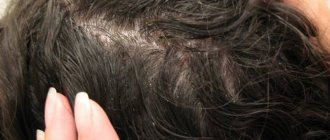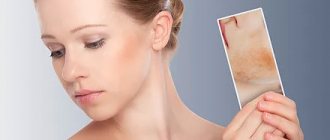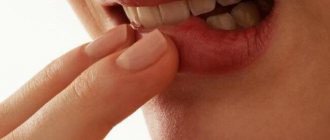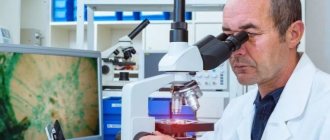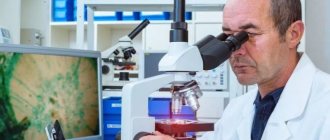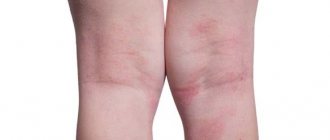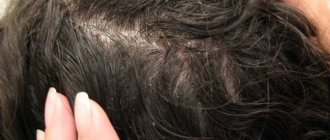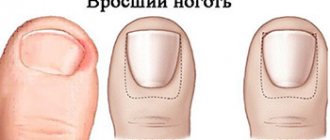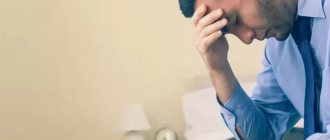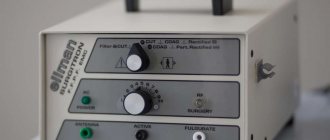From this article you will learn:
- Description of androgenetic alopecia
- The effect of androgens on hair condition
- Risk factors for developing androgenetic alopecia
- Symptoms of androgenetic alopecia
- 2 types of androgenetic alopecia
- Diagnosis of androgenetic alopecia
- 3 Ways to Treat Androgenetic Alopecia
- Drug therapy for androgenetic alopecia
- Treatment of androgenetic alopecia in men and women
- Laser therapy
- Mesotherapy and hair transplantation
- Treatment of androgenetic alopecia with traditional methods
Androgenetic alopecia is a special type of baldness that affects both men and women. This disease occurs due to hormonal imbalances that provoke intense hair loss in certain areas of the head. In the stronger half of humanity, such thinning of hair appears after 30 years, and in women after 50.
Various methods are used to treat alopecia, including medications, physical therapy, and surgery. The method of therapy is selected by the doctor depending on the causes of the disease.
Description of androgenetic alopecia
Alopecia is baldness. Androgenetic alopecia is a disease caused by increased sensitivity of hair follicles to dihydrotestosterone, the active form of the male sex hormone testosterone.
This hypersensitivity of the follicle to testosterone is a genetic disorder, which in 75% of cases is transmitted to the child from the mother. Medicine believes that androgenetic alopecia is a hormonal disease that can be hereditary.
Recommended articles on the topic:
- Diffuse alopecia in women
- Plasma therapy for the scalp
- Useful vitamins for hair: against hair loss and for growth
Androgenic (androgenetic) alopecia in men begins to develop in the frontal and parietal regions. Women first lose hair in the area of the central parting, then the hair thins on the top of the head. At the very beginning, the disease manifests itself in thinning hair and deterioration in its appearance. They become dull, lifeless and then fall out. Androgenetic alopecia is difficult to diagnose at first because it develops very slowly. The first signs of pathology appear only at the age of 30, and baldness becomes noticeable only after 10–15 years.
Many people note that with complete baldness of the frontal and parietal parts of the head, the back of the head remains covered with thick hair. This is a characteristic sign of androgenetic alopecia and is due to the fact that the follicles in this area are not sensitive to changes in the level of dihydrotestosterone in the human body.
I bet I can keep the wig
Wigs are an old way to solve the problem of baldness. Modern artists have freed “hairy headdresses” from such side effects as sliding on one side, changing their presentation in the rain, in water and in the bath. Today, wearing wigs, you can swim in pools and comb your hair in public without fear. A papier-mâché type impression is made of the patient’s head, and natural or artificial hair is selected. There is also a technology that allows you to sew a wig to your head. But it, like hair implantation, is yesterday’s “hair growth.” The operations did not become popular because they caused a lot of unpleasant troubles. The genetically foreign material “implanted” into the skin was rejected over time. Approximately 30% of those “planted” during implantation of artificial or natural, but foreign hair, left the head within one and a half to two years; after 5-7, almost all the hair “gone”. Patients were forced to undergo regular cleanings in beauty salons, agree to “add-on” hair, eventually receiving, at best, a natural bald spot, at worst, a bald spot strewn with boils.
The effect of androgens on hair condition
Male sex hormones are collectively called androgens. They are produced in all people, but their quantity is related to gender; women have significantly less such hormones.
One of the androgens is testosterone, due to its high level in men:
- large and strong muscles;
- hair grows in large quantities not only on the head, but also on the face and body;
- mammary glands do not develop;
- a characteristic male voice, low and rough, and good stamina.
Androgens are necessary for the metabolic process and are responsible for normal sugar levels. The strength of their effect on the body differs, so androgens are divided into two groups - weak and strong. Testosterone, already familiar to us, and its weaker version, dihydrotestosterone (DHT), belong to the strong group. They are part of the enzyme 5-alpha reductase, which, with a genetic predisposition, can be present in the scalp and can cause the development of androgenic alopecia.
Despite the fact that androgens and estrogens have common metabolic processes, their effects on the body are opposite. The lifespan of hair depends on estrogen levels. One of them, estradiol, is especially actively produced during pregnancy. This is why women in interesting situations have hair that becomes thicker and practically stops falling out.
In the first weeks after childbirth, estrogen production decreases sharply, and hairs in the growth phase begin to fall out, and the hair noticeably thins.
First signs
If you notice that you have shaggy areas, bald spots, bald spots and other imperfections instead of your once rich and luxurious head of hair, you need to think about the state of your health and urgently look for the mechanism that triggered the pathology. However, the listed signs are evidence of an activated process that has taken a pronounced course and is gaining speed of development.
However, there are also cases when a person, seeing a minimal loss, begins to panic and worry. In fact, a person normally loses a certain amount of their hair every day. Usually it is up to 150 units per day. It is important to separate the norm from the pathology and, if alarming signs are identified, contact a specialist in a timely manner.
On average, one hair lives 3–7 years. At the end of this period, it falls out, and a new one appears in its place. If you notice that after using a comb, some units remain directly on it, or you find them on the pillow after sleep, do not worry - this does not indicate the development of baldness and is not evidence of the disease. Also remember that our strands do not grow at the same time, they are constantly renewed. But there is a constant reserve on the head, 90% or more percent - it never runs out.
Before you look for the answer to the question of what helps hair loss in men, you need to determine whether you are actually going bald. Analyze your current state. This can be done using the simple tests described below:
1. Carefully examine your skin to see if patches of baldness are beginning to form. 2. Pull the curls - they should not separate easily. 3. Inspect your clothes, pillow after sleep, the back of your work chair, sofa, coat. How many hairs do you lose and how regularly do they appear there? 4. Monitor yourself during the washing procedure. Do large strands remain in the drain hole? Continue to monitor this for 2-3 weeks to confirm or deny the development of pathology. 5. Gently comb your hair. Carefully inspect individual units; if you see a white tip on them, you need to sound the alarm and start taking action, as this means the loss of vegetation at the root. This is usually a direct symptom of baldness.
Risk factors for developing androgenetic alopecia
When studying the causes of androgenetic alopecia, experts identified several factors leading to the development of pathology:
- Gender. Men suffer from androgenic pattern baldness 4–5 times more often than women.
- Age. Every second man and fourth woman over 50 years old finds signs of androgenetic alopecia.
- Hormonal imbalance. Hormonal imbalance in women usually occurs after pregnancy or during treatment with medications containing male hormones. In men, the cause of alopecia can be the use of drugs that activate testosterone production, for example, various types of doping agents.
- Heredity. If androgenetic alopecia was identified in previous generations, or if relatives suffered from severe hair loss for no apparent reason, then the probability of this pathology occurring in subsequent generations is close to 80%.
- Various types of tumors and damage to the glands that produce sex hormones.
- Hyper- or hypofunction of the pituitary gland.
- Oncological formations in the adrenal glands or increased function due to certain diseases.
- Decrease or increase in the level of hormones produced by the ovaries and testicles in orchitis, polycystic disease, ovarian sclerocystosis, ovarian disease.
If the patient has at least one of the listed risk factors and his hair has noticeably thinned, then you should not postpone a visit to the dermatologist. After examination, the doctor will either decide that it is androgenetic alopecia or diagnose another cause of hair loss.
Prevention of baldness
The causes and treatment of alopecia are different, but in order to prevent the onset of the disease, it is important to follow the advice of experts in this field:
- Take good care of your hair, wash it regularly, use high-quality shampoos and conditioners.
- Give up bad habits, do not abuse alcohol and tobacco.
- Stick to a diet, do not eat large amounts of salty and spicy foods.
- Wear hats in strong sunshine, as UV rays have a detrimental effect on the follicles.
- Eat enough fresh fruits, vegetables, herbs, and do not adhere to a low-calorie diet for a long time.
- Protect yourself from stress and depression, try to maintain a daily routine and get enough sleep.
If you strictly follow these simple rules, the likelihood of baldness in your life will be significantly reduced. If you are unlucky, then do not despair, medicine is moving forward, new medications and techniques are being developed every year to promote healing.
Symptoms of androgenetic alopecia
Determining that hair loss is the result of androgenetic alopecia is not so easy. Symptoms may be mild; the correct diagnosis will depend on the gender of the patient and examination of the hair for pathological changes. The only characteristic sign is damage to the hair follicles only in the forehead and crown of the head, because it is in these parts of the hairline that an enzyme sensitive to dihydrotestosterone is found.
The manifestation of androgenetic alopecia in women may look like:
- decrease in hair density in the frontal and parietal parts of the head, but it does not reach complete baldness;
- changes in the menstrual cycle - androgens interfere with the work of estrogens, which causes menstrual irregularities;
- acne, usually appearing on the face and back;
- hirsutism – hair growth in places where women traditionally do not have pronounced hair (chest, back, face).
Androgenetic alopecia in men makes itself felt by sparse vegetation in only two areas of the head - frontal and parietal.
Bald dad, bald grandfather...
Scientists and doctors are still arguing about why people go bald. Even the now seemingly accepted hormonal or “androgenic” theory of baldness raises many questions. Already because it does not explain the purely local nature of this action. Attempts to blame everything on the mysterious “baldness gene” cannot satisfy experts. Although there is no doubt that baldness is often familial and hereditary in nature - if the grandfather and father have little hair on their heads, then the son will most likely face a similar fate. At a certain point, genes inform the hair roots that it is time to die.
Diagnosis of androgenetic alopecia
Sometimes androgenetic alopecia is determined based on a visual examination, since in patients with this pathology the level of hormones in the blood does not exceed normal. To exclude other possible causes of severe hair loss and determine effective treatment, diagnostic and laboratory tests are prescribed.
Types of tests for androgenetic alopecia in women and men:
- biochemical blood test - to determine the amount of microelements;
- tests for TSH, T3, T4 - for the presence of thyroid hormones;
- tests for sex hormones - to determine the level of testosterone, prolactin, estrogen;
- complete blood count and serum iron test;
- analysis for the level of adrenocorticotropic hormone (if adrenal disease is suspected).
If this is necessary, then to complete the picture, the attending physician may prescribe an ultrasound of the adrenal glands and a CT scan of the brain. The patient is referred for consultation to an endocrinologist, gastroenterologist, gynecologist, neurologist, and trichoscopy is performed.
The sun is also... bald
“So,” you ask, “is there really only one thing left - to take the fatherly advice from a book on cosmetology: “Accept the inevitable or get a wig”? It's not all hopeless. As already mentioned, it all depends on the type of baldness and the cause of its occurrence. If the cause of alopecia is determined, the prospect of a cure improves. Contact a specialist, preferably a trichologist, he will help you solve this problem. And finally, I would like to quote one phrase that may cheer you up and at least somehow reconcile you with hair loss. “I lost my hair, I lost my youth, what a shame! — a certain 16th-century Zen Buddhist composed haiku. “But I look—the calm sun is rising.” Like a bald head."
Mesotherapy and hair transplantation
Mesotherapy is the introduction of medications directly under the skin, as close as possible to the hair follicles. For therapeutic injections, combinations of vitamins and microelements are used. This method speeds up metabolism and fills the follicles with nutrients. Hair plasma lifting works in a similar way, when instead of drugs, blood plasma taken from the patient’s vein is injected under the skin.
Painful sensations during subcutaneous injections are minimal. In terms of time, one session is about 40 minutes; to obtain a visible effect, it is necessary to carry out at least 10 procedures. For androgenetic alopecia, the drug “Dutasteride” is used for medicinal mixtures as the most effective. Almost two thirds of patients who have undergone 12 sessions of this mesotherapy note a noticeable improvement in the condition of the scalp. In the photo, androgenetic alopecia becomes almost invisible.
For those who do not like injections, mesotherapy can be performed using a mesoscooter. There will be results too, but not quickly.
Not long ago, another method of treating androgenetic alopecia appeared - hair transplantation. In the first operations, artificial or foreign hair was used as transplant material. But in the postoperative period, many complications arose in the form of purulent inflammation and rough scars. Now the patient's own hair is used for transplantation. 1-2 follicles along with pieces of skin (grafts) are taken from the occipital or behind-the-ear area.
“A bald spot means he’s walking around!”
Not much is known about the predisposition to baldness itself. There is an opinion that rural residents are much less prone to it than city dwellers, and people of intelligent professions go bald more often. There are more bald people among people with a picnic build and bosses (obviously due to periodic stress). Even ancient authors spoke about the connection between baldness and temperament. And in Avicenna’s “Canon” it is said directly: “Baldness quickly occurs in a person with a hot nature, since his juices quickly dry up.” It is surprising that almost the same words were used to interpret premature baldness by the ancient Chinese.
Treatment of androgenetic alopecia with traditional methods
Since ancient times, traditional medicine has offered various ways to strengthen hair, increase the density of curls, and reduce the rate of baldness. But all of them will give the expected effect only when used together with medications.
- Onion rub. At the first signs of thinning, it is recommended to rub a mixture of chopped onion into the hair roots. Leave the mask on for an hour and a half, then wash off with strengthening or regular shampoo. If you add crushed garlic and a little honey to the onion mass, the procedure will be even more effective.
- Pepper tincture. Grind the pepper, pour in 100 ml of vodka and leave for 24 hours. Then rub the tincture into the scalp and after an hour and a half, wash your hair thoroughly.
- Onion-cognac tincture. Grind a medium onion through a meat grinder and pour 200 ml of cognac into it. The mixture should sit for several hours. To achieve a positive result, the tincture must be rubbed into balding areas of the head daily.
- Mustard mask with castor oil. Take one tablespoon of dry mustard, mix it thoroughly with 30 ml of castor oil and let it brew for 20-30 minutes. To reduce the amount of hair falling out, a mustard mask should be applied to the scalp for 40–50 minutes. The session is carried out before each hair wash 1-2 times a week.
- Nettle lotion. The therapeutic effect is obtained by using nettle for androgenetic alopecia. In a saucepan with 5 tbsp. spoon leaves, pour 450 ml of water, add 2 tbsp. spoons of vinegar and put on the stove. Bring the mixture to a boil, keep on low heat for half an hour, then remove and cool. The product should be rubbed into the scalp every day before bed.
- Salt mask. Good results are obtained by rubbing regular or sea salt into the scalp 30–40 minutes before washing it.
- Mask with vitamins and Dimexide. Mix 2 tbsp. spoons of castor and burdock oil, add to them 1 teaspoon of vitamins A, E and 1 tbsp. spoon of Dimexide. The prepared mixture is rubbed into the roots of thinning hair and left for one hour.
- Tincture to strengthen follicles. Pour 1 tbsp into a jar. spoon of nettle and crushed burdock root, pour a glass of alcohol, add 1 bottle of alcohol tincture of mint and propolis. Close the jar tightly and put it in a cool place for a week. Then filter the composition and pour into a container with an airtight lid. Rub the resulting lotion daily before bed.
- Mask with sea buckthorn oil. Mix 1 teaspoon of sea buckthorn oil with 6–8 drops of grapefruit oil, 1 teaspoon of vitamins A, E and heat in a water bath. Then add 1 spoon of Dimexide to the mixture. Apply the mixture to the hair roots and leave for an hour.
Due to the fact that androgenetic alopecia is difficult to treat, some medications will have to be used throughout life, taking short breaks between courses. Otherwise, baldness will progress.
Why clients choose Veronika Herba Beauty and Health Center:
- This is a beauty center where you can take care of yourself at a reasonable cost, while your face and/or body will be treated not by an ordinary specialist, but by one of the best in Moscow. This is a completely different, higher level of service!
- You can receive qualified help at any time convenient for you. The beauty center is open from 9:00 to 21:00, seven days a week. The main thing is to agree with your doctor in advance on the date and time of your appointment.
Sign up for a consultation with a specialist by phone +7 (495) 085-15-13
, and you will see for yourself!
Donkey teeth, radishes, garlic... “fighters” against baldness
With what methods has mankind fought against baldness throughout its existence? The Egyptians, for example, rubbed powdered donkey teeth with honey and olive oil with hippopotamus fat into their balding heads. Baldness was combated by rubbing (onion peel, garlic, radish), massage and steaming, after which ointments with medicinal plants (nettle, burdock and burdock) were added. And today, similar advice regularly appears in the tabloid press. To germinate a fuzz on the head, improvised means such as castor oil, aspirin tablets dissolved in water, or even hatched pigeon eggs are used. The consequence of such actions is only disappointment. Nowadays, a head suffering from baldness is bombarded with the entire arsenal of remedies accumulated over centuries - from homeopathy, acupuncture, vitamins and ending with microcurrents and chemistry. Most acquired hair diseases are treatable and sometimes go away on their own with lifestyle changes.
